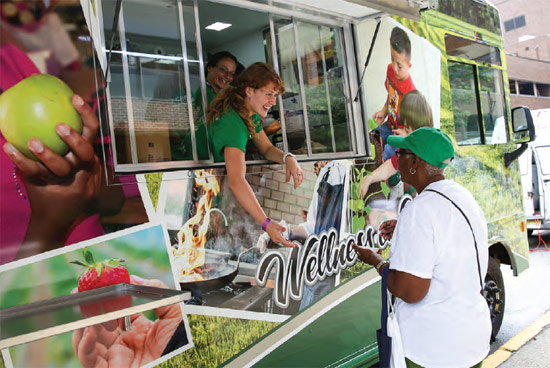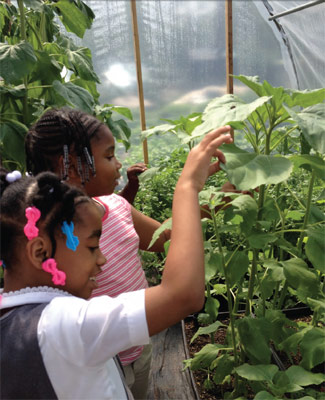Economic Stability

In order to improve the health, social and economic outcomes of New Jersey residents, it is imperative to ensure that they are able to access their basic needs. The SICI team has developed targeted interventions that address:
- Food Security
- Youth Workforce Development
- Access to Services & Supports
FOOD SECURITY
Healthy communities are food secure. People have opportunities to make healthier food choices if communities produce, rather than import, their own food and have more local food distribution centers (farm and retail). In healthy communities, families and individuals do not have to rely on emergency sources for food; there are ample food hubs with culturally appropriate products within reasonable proximity to where people live.
A food desert is an area, especially with low-income residents, that have limited access to affordable and nutritious foods. Processed, sugar and fat-laden foods are known contributors to the U.S.’ obesity epidemic and although not always connected, many people may be overweight or obese and still suffer from hunger and malnutrition due to the food choices available and affordable. Four out of ten adults living in the U.S.. are facing obesity. Fifty disorders are linked to obesity including but not limited to type 2 diabetes, cardiovascular disease, high blood pressure, and some cancers. Additionally, one out of three children becomes overweight or obese before their 5th birthday. Further, nearly $1.5 trillion is spent annually for direct and indirect costs associated with obesity.
4 OUT OF 10 ADULTS LIVING IN THE U .S. ARE FACING OBESITY
2019–2020 GOALS & KEY OBJECTIVES
GOAL 1
Strengthen the local food supply chain to adequately address all aspects
from production and distribution to management, as evidenced by increased
food distribution, production and access and increased utilization of
community food markets.
Community members have access to affordable, nutritious food when there is a “diversified food system in place that addresses food production, distribution, and preparation as well as waste reduction and use.” The focus of SICI over the next two years is to further cultivate healthy local food supply chains and strong partnerships with traditional farmers with a focus on Newark through a distribution model.
-
Establish Newark Riverfront Food Marketplace, a collaborative initiative
with Rutgers Business School and Food innovation Center and the City of
Newark. In collaboration with Rutgers Business School and Rutgers Food
Innovation Center, SICI supports the design and development of the largest
food supply chain network in the region; an effort that will result in
one of the largest riverfront food market destinations on the East Coast.
The Newark Riverfront Food Market will be accessible and available to
Newark residents and visitors.
- Secure expert to perform a feasibility study, in partnership with Rutgers Business School.
- Co-design a business plan with Rutgers and the targeted community leaders with the aim of creating food hubs in each of the wards in Newark.
- Conduct community asset mapping, in concert with NBIMC and GCNAB, inclusive of community convenings.
- Continue conversations that lead to solutions with both traditional and urban farmers to discuss common goals and barriers around food distribution to areas/populations in most need.
-
Design and deploy Wellness on Wheels, a mobile greenhouse demonstration
and nutrition education center designed to increase access to healthy
foods, provide nutrition education and urban farm distribution, provide
volunteer opportunities to clinical students and RWJBarnabas Health employees,
offer health screenings, and increase the number of families who are knowledgeable
about good nutrition.
- Establish a Veggie RX program developed in conjunction with WOW.
- Develop Community Tool Kit and business plan modeling for external publication.
- Expand hydroponic greenhouse effort into a minimum of one (1) additional key site throughout the RWJBH system. The Beth Greenhouse at Newark Beth Israel Medical Center serves as a pilot of education modalities. This model, in addition to planned expansion sites, serves as a point of distribution for both urban and traditional farmers as well as a platform for job training for all populations, including those with disabilities and behavioral health issues, and supports the practice’s policy goals by accepting government benefits programs.

GOAL 2
Facilitate more efficient food distribution models by strengthening relationships
between urban farmers and traditional farmers, as evidenced by increased
levels of cooperation and collaboration among urban and traditional farmers
and increase produce in urban areas.
A collaborative partnership needs to be fostered between the local farmers in urban areas and the traditional farmers of New Jersey. This will help to create an efficient, more inclusive distribution model that brings food grown in the Garden State to those areas that are in the most need of healthier food options. Both groups of farmers can work together to establish a working model beneficial to all parties.
-
Enhance the existing distribution model to vulnerable communities through
the coordination of a statewide urban and traditional farmer collaborative,
as evidenced by increased knowledge and leadership capacities of urban
and traditional farmers, and supply chain partners.
- Identify urban and traditional farming collaboratives across the state with special emphasis on diverse and inclusive participants.
- Co-convene initial meetings to determine issues/needs.
- Support pilot initiatives that foster partnerships between both farming groups.
GOAL 3
Advocate for sound federal, state, and local policies that advance favorable
conditions for community farming; new food and farming markets and enterprises;
streamline access to federal food support programs; as well as expand
access to healthy, affordable food in our communities.
Advocacy efforts that support community-based agriculture and the traditional farmer as well as address other issues related to family food security are critical for impact and sustainability. Based on feedback from the GNCAB as well as learnings from the Food for Thought documentary and subsequent community convenings, the SICI practice has begun its advocacy efforts with a specific emphasis on urban agriculture, food assistance programs and procurement.
- Continue work with ChangeLab and GNCAB to develop and prioritize advocacy strategy based on Food for Thought documentary convenings.
- Engage with federal and state government to eliminate 5-acre rule as condition of becoming a WIC vendor and, once change adopted, support the State in its rollout and local community farmers in accepting these benefits.
- Work with State to adopt regulations or policy change to effectuate recently-signed legislation streamlining WIC and SNAP vendor applications.
ACCESS TO SERVICES AND SUPPORTS
From transportation to federal benefits, individuals throughout New Jersey have difficulty accessing the services that are available to them. Anchor institutions must leverage their capacity, to use their collective resources to help individuals connect to the services that are available to them. For example, in New Jersey, while approximately 74% of eligible individuals participate in the Supplemental Nutrition Assistance Program (SNAP), thousands more who are eligible remain unenrolled. Lack of access to necessary services and supports can lead to worsening health outcomes.
GOAL 1
Screen and appropriately address the social needs of patients who present
in RWJBH system facilities in targeted geographies, as development and
implementation of a standardized screening tool; development of standard
and streamlined protocols for addressing SDOH once identified; increased
number of patients screened; and increased number of individuals appropriately
connected to social services in targeted sites.
Maximizing the use of anchor institutions as access points is critical. As individuals walk through the doors of RWJBarnabas Health and their health care needs are assessed, so should their social needs. However, recognizing that clinicians and support staff are overburdened, it is essential to best use data and technology to most efficiently and effectively assess and refer patients to the services that can meet their immediate and sustained social needs.
- Identify what SDOH screening efforts are already underway throughout the system.
- Convene a multidisciplinary, cross-system team of individuals to oversee and implement the objectives included within this goal.
- Collaborate with internal and external stakeholders to identify and secure a tool to track patients’ connection to social services that can be shared between RWJBH and partnering community-based organizations.
- Develop or identify shared consent agreements that can be used to share patient data with partnering agencies.
- Coordinate with implementation of a SDOH screening tool in a minimum of 4 targeted facilities/ geographies/service lines.
- Support community-based organizations to screen individuals for the SDOH and connect them to necessary services, with a special emphasis on high utilizers.
- In collaboration with Rutgers University, actively develop research models that assess health and social outcomes that occur when individuals are provided a full complement of services, and determine which services produce the best health outcomes and most savings.
“A food desert is an area, especially with low-income residents, that have limited access to affordable and nutrition foods. Processed, sugar and fat-laden foods are known contributors to the U.S. obesity epidemic.”



